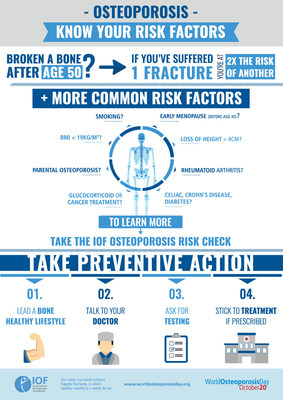Worldwide, one in three women and one in five men aged 50 or over will sustain an osteoporosis-related fracture. Approximately 200 million people are affected, resulting in a fracture every 3 seconds.
On World Osteoporosis Day, October 20, the International Osteoporosis Foundation (IOF), together with its 250 member organizations worldwide, urge all older adults to be aware of osteoporosis risk factors and to consult their doctors if they are at risk.
Although there are many factors which can point to possible underlying osteoporosis, among the most common are: a broken bone after age 50 following a low-trauma fall; height loss of more than 4 cm (ca 1.5 inches); long-term use of glucocorticoids and other bone damaging medications; being frail and underweight; and parental history of osteoporosis or hip fracture.
A fracture in one's senior years can be life-changing. Acute pain, lengthy rehabilitation, long-term disability, dependence on caregivers, and loss of quality of life are all too common. Hip fractures can be life-threatening and loss of function and independence among survivors is profound, with 40% unable to walk independently and 60% requiring assistance a year later. Because of these losses, 33% are totally dependent or in a nursing home in the year following a hip fracture.
IOF President Professor Cyrus Cooper, states:
"All adults must make their bone health a priority. Maintaining strong bones and muscles is the key to an active, mobile future at older age. If you're at risk, don't hesitate to ask your doctor for testing and an appropriate treatment strategy if needed. Today, there is a wide range of effective osteoporosis treatments which have been shown to reduce the risk of hip fractures by up to 40% and spine fractures by 30-70%."
IOF also calls on health authorities to prioritize bone health and thereby reduce the costly human and economic burden of fragility fractures in their countries.

 Worldwide, one in three women and one in five men aged 50 or over will sustain an osteoporosis-related fracture.
Worldwide, one in three women and one in five men aged 50 or over will sustain an osteoporosis-related fracture. 









.jpeg)

.jpeg)
.jpeg)

.jpeg)


.jpeg)



.jpeg)
.jpeg)
.jpeg)


.jpg)


.jpeg)
.jpeg)